Each time I come across a different method of joining yarn in knitting, I wonder what other methods I'm missing. Maybe the perfect method is out there, waiting to be found?
So I trawled the knitternet, tried all the methods I found and listed them here, along with some thoughts on when you might use each of them.
Read through the full list below, or choose one or more of the filters to narrow down your options.
What would you like?
Found 20 methods.
Alternating stitches in old and new yarn
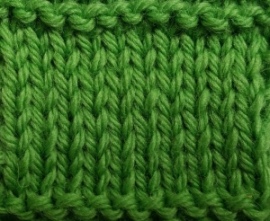
How to do it: Make one stitch using the new yarn, and then use the tail end of the old yarn to make the following stitch. Continue to alternate between the new and old yarn for a total of 6 to 8 stitches. Weave in the ends later.
Pros: Neat and quick if you're already familiar with stranded/fair-isle knitting. Suitable for any fiber.
Cons: Not suitable for a color change. You need to weave in the ends.
When to use: It's not a join that I use myself, as I find the Twist-and-Weave method quicker. But I was surprised at how neat this is.
Back join
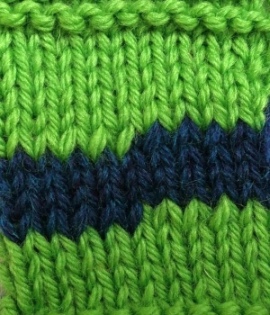
A way of changing color at a specific point in your work, locking in the yarn ends at the same time with double-stranded stitches.
How to do it: Find and mark the point in your yarn where you will change color. Loop the yarn back on itself at that point, then knit with both sides of the loop, held together as a double strand, until just before the color change. Thread the new color through the last bit of the loop in the old color, and knit with both strands of the new color loop for a few stitches to lock in the new tail.
Further details: Picture tutorial from TECHKnitter.
Modification: For intarsia knitting, only work the double stitches with the new color, leaving the old color available for continuing the color pattern on the next row.
Pros: Suitable for changing color at a specific stitch. No ends to weave in later.
Cons: The double-thickness stitches are visible on the front of the fabric, and the thicker the yarn, the more noticeable they'll be.
When to use: Suitable for stripes, especially working in the round, where you don't mind having double-thickness stitches. The modified method is suitable for intarsia and stranded colorwork.
Braided join
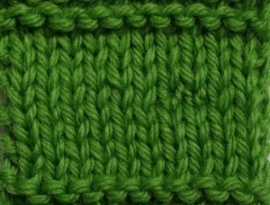
Braid (plait) the two yarns together.
How to do it: With the last 8cm/3 inches of tail in the old yarn, separate the plies into two sections. Hold the end of the new yarn at the divide point of the old yarn, making three strands in total. Tightly braid the three.
Further details: Video tutorial from Lorraine L.
Pros: No ends to weave in later. Suitable for any fiber. Neat on both the front and back of the fabric.
Cons: Not suitable for single ply or novelty yarns. Not suitable for changing color. Takes a little time.
When to use: Use for a same-color join in plied yarn where you want the back to look neat as well as the front. The join is visible, but you'll be the only one who can find it! If you're using a feltable yarn, the Wet Splice is probably neater.
Just knit with it
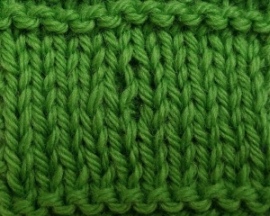
How to do it: Drop the old color, loop the new color over the needle and just start knitting with it. Weave in the ends later.
Pros: The easiest method of all.
Cons: The stitches become loose, affecting the tension of neighboring stitches. Even if the join is at the edge of the fabric and will be enclosed in a seam, the loose stitches in the surrounding area are likely to be visible.
When to use: I wouldn't recommend this method at all. Even an absolute beginner should Tie A Knot instead.
Knot and cut tails
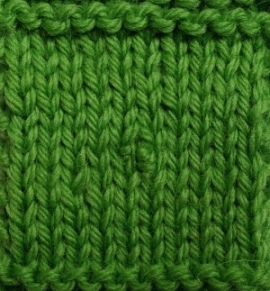
Knot visible in the center of the picture!
How to do it: Knot the two ends of yarn together using a strong knot that (hopefully) won't come undone. Cut the yarn ends off close to the knot, and then continue, treating the knot as if it's not there.
Possible knots to use include a weavers knot, a 'flawless' knot, or a 'magic' knot (also known as double or fisherman's knot). Of these, the only one where the knot consistently held firm for me as I pulled the two yarns apart was the 'magic' knot.
Further details: Video tutorial of the magic knot from Curious Handmade.
Pros: No ends to weave in. A way of joining different lengths of yarn together into a 'gobstopper ball', sometimes called a 'magic skein'.
Cons: There's about a 50% chance of the knot ending up on the front of the work unfortunately! There's a risk of the knot coming undone. Not suitable for a color change—not at a specific stitch anyway. Not suitable for something like socks, where you might end up standing on a knot.
When to use: I might use the magic knot to make a gobstopper ball, where a range of leftovers are joined to make a self-striping yarn. Even then I think I'd avoid the knots and use a Russian or braided join.
Overcast (from TECHKnitter)

A way of changing color and weaving in the ends of yarn as you work, without having double-thickness stitches.
How to do it: At 6 or 8 stitches from a color change, loop the old color yarn over a finger and hold it away from the needle. Work the remaining stitches before the color change alternating between taking the needle under or over the tail end of the yarn that you're holding. This catches the tail of yarn into the stitches, showing only on the back of the fabric. Later weave in the tail of the new color yarn using a similar method.
Modification: For intarsia knitting, only weave in the new color tail, leaving the old color available for continuing with the pattern on the next row.
Further details: Picture tutorial from TECHKnitter.
Pros: Very neat on the front. Suitable for changing color. All stitches are single-thickness. No tails left to weave in. No accessories needed. Suitable for any fiber. The modified method is suitable for intarsia and stranded colorwork.
Cons: Takes some effort to master. You have to remember to stop far enough away from the color change. Not invisible on the back.
When to use: Suitable for changing color for stripes, especially working in the round, and where you don't want to weave in the ends later. The modified method is suitable for intarsia and stranded colorwork.
Overlap and knit double
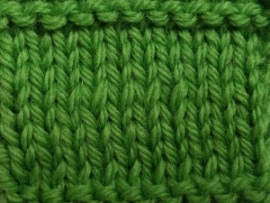
Work a few stitches with both ends of yarn, held double.
How to do it: Hold the old and the new yarn together, with the end of the new yarn in the opposite direction to the tail of the old yarn. Knit 4 to 6 stitches with the yarns held double, before dropping the old yarn and continuing with the new. When you come to work those stitches again, treat the double strands as one stitch not two. There's no need to weave in the ends later, just cut them off a short distance from the back of the fabric.
Further details: Video tutorial from Jimmy Beans Wool.
Pros: Quick and easy. No ends to weave in. Neat enough with fine yarns.
Cons: Noticeable on the front of the work, becoming more noticeable the thicker the yarn. Not suitable for a color change.
When to use: With fine yarns (DK weight and below), or fuzzy/tweedy yarns where the double weight stitches won't show.
Russian join

How to do it: Loop the tails of the two yarns around each other and use a needle to thread each tail back on itself and down through its own core, trapping the tail of yarn within.
Further details: Picture tutorial from Knit Picks and a video tutorial from VeryPink Knits.
Pros: Fairly neat, strong, no ends to weave in later. Suitable for all fibers.
Cons: The double weight of yarn is sometimes visible. Difficult to do with a single or 2-ply yarn. Not suitable for a planned color change. Requires you to find a blunt-ended needle. Takes a little time.
When to use: If you're using a plied yarn, not making a color change and need the back to look neat as well as the front. If you're using a feltable yarn, the Wet Splice is probably neater.
Staggered splice
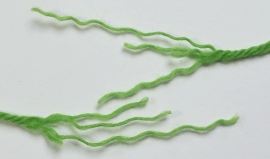
Plies cut to staggered lengths
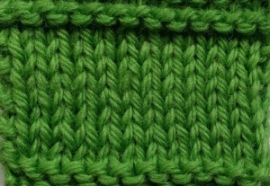
How to do it: The same as the wet splice, but before felting the ends together, separate the plies in both ends of yarn and cut (or break) the plies at staggered lengths. When you wet-splice the two together they join to make a yarn of single-thickness.
Pros: Makes a nearly undetectable join for any weight of feltable, plied, yarn. No ends to weave in.
Cons: As for the wet-splice, this only works with feltable fibers, such as non-superwash wool and cashmere. It's more difficult to achieve the same effect with single ply yarns. Takes a little time to do.
When to use: Use with plied, non-superwash wool or cashmere yarns that are DK-weight or above.
Tie a knot
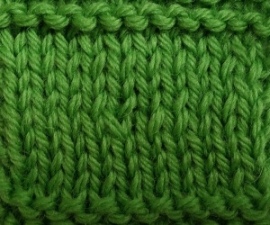
How to do it: Drop the old yarn, start with the new yarn, stop after a few stitches and tie a knot in the two ends. Make it fairly loose if you want to untie and weave in the ends later, or make it tighter and leave the ends hanging.
Pros: Easy to do. Use for any fiber.
Cons: You have to stop to tie the knot a few stitches after the join. It still might not look neat on the front.
When to use: If you're an absolute beginner and don't want to learn a new technique at this minute. I know that some knitters of very fine pedigree knot their yarn ends and don't worry about weaving the tails in, but it's (k)not for me. Knots restrict the natural movement of yarn between stitches, there's always the risk they'll unravel, and they sometimes work through to the front of the fabric.
Twist-and-Weave
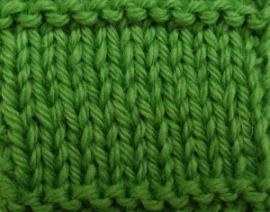
Twist-and-weave method without changing color
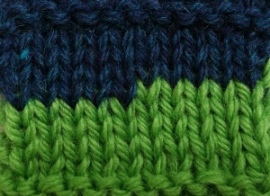
Twist-and-weave with color change
How to do it: Interlock the two yarns before catching in the new tail end behind the following stitch. See the picture tutorial on YarnSub.
Modification: Use the 'weave' part of the technique to catch in the tail of yarn a couple of times at the back of the fabric to avoid having ends to sew in later.
Further details: There are two videos: one for knitters who hold the yarn in their right hand/Throwing style and one for left hand/Continental style knitters.
Pros: Suitable for a color change. Stops stitches coming loose without use of a knot. Very quick and easy once you've learnt it. Neat on the front. Suitable for all fibers and yarn constructions. No double thickness stitches. No ends to weave in if you use the modified version and continue weaving in the ends as you work.
Cons: Takes a little effort to learn. The join is visible on the back.
When to use: I love this join and use it nearly all the time. The only time it's not suitable is for reversible fabric where you want the back to look as good as the front.
Wet splice
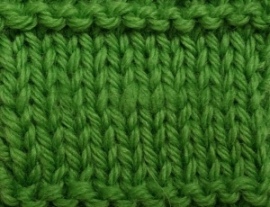
Also known as: spit-splicing, felted splice
How to do it: Overlap the old and new ends of a feltable yarn in the palm of your hand, by about 5cm/a couple of inches. Wet the palm of your hand (you don't need much liquid, hence it's also called spit-splicing, but that makes me too queasy, and I always use water!) Rub the ends together between your palms, until they have felted together.
Further details: Video tutorial from WEBS.
Pros: Makes a join that looks good on both the front and back of the work with non-superwash wool, especially when it's fingering/4-ply weight or below. No ends to weave in.
Cons: Not suitable for any fiber that doesn't felt, and makes an ugly join even with some that do—I wouldn't use it for alpaca or llama. For heavier yarns, the join is visible on the right side of the fabric. Not suitable for a color change. The felted area can be seen, especially with heavier-weight yarns.
When to use: This is my favorite method for non-superwash wool and cashmere, for yarns that are 4-ply/fingering weight or below. I also use it for single-ply wool right up to super-bulky weight. For plied DK-weight yarns and above, I use the staggered splice method.
Still unsure?
If you're just learning to knit and feel overwhelmed by the options, I would start with Tie A Knot.
When you feel more confident, move onto the Twist-and-Weave method, a quick and neat join for almost every other situation.
If you need the back of the fabric to look as good as the front, go for the Wet Splice if you're using feltable wool of DK-weight or below and the Staggered Splice above DK-weight. If you're using a non-feltable fiber and you need a neat join front and back, try the Braided or Russian join.
A final note—weaving in ends
Ysolda has a great article on weaving in ends. My favorite of the methods she talks about is using a sharp needle to skim the ends through the back of the surrounding stitches in a zig-zag pattern.
Let me know if I've missed any yarn joining methods!
—Wendy
P.S. If you haven't yet signed up to our Yarn Geeks newsletter, use the form below!
